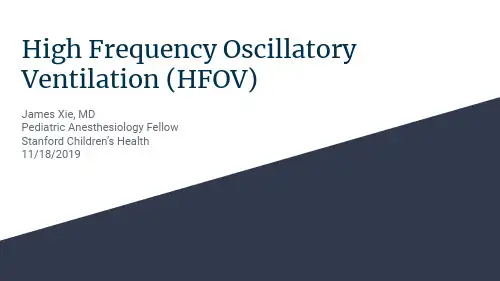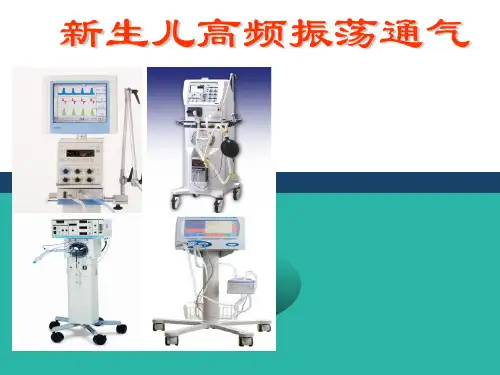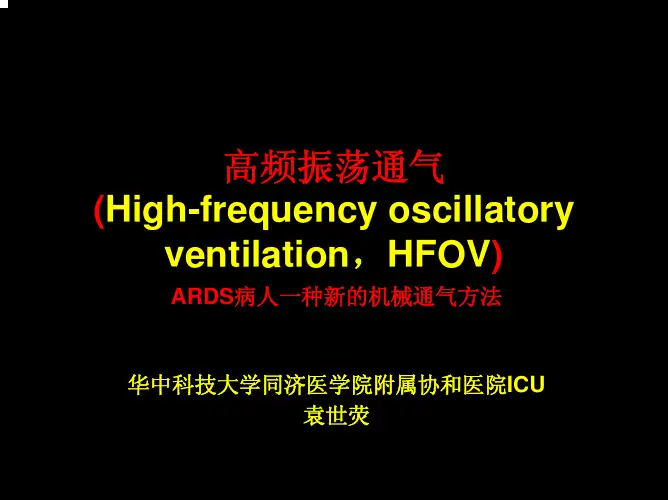高频振荡(HFOV)通气
- 格式:ppt
- 大小:355.50 KB
- 文档页数:29





高频振荡通气高频通气(high frequency ventilation,HFV)是指通气频率超过150次/分(2.5 Hz, 1 Hz=60次/分)的通气方式。
高频通气是1959年由Emerson首次发展起来的新技术,随着时间的推移逐步衍生出多种高频通气方式。
一般按照其气体运动方式将高频通气分为五类:1.高频正压通气(high frequency positive pressure ventilation, HFPPV)2.高频喷射通气(High frequency jet ventilation,HFJV)3.高频振荡通气(high frequency oscillatory ventilation,HFOV)4.高频阻断通气(High frequency flow interruption ventilation,HFFI)5.高频叩击通气(High-frequency flow interruption ventilation,HFFI)高频振荡通气以其可清除CO2、不易引起气压伤、小潮气量、操作简便、副作用少的优点,在近年来逐渐成为高频通气的首选。
经过多年的经验积累,高频振荡通气在儿科已经成为儿科重症治疗的首选通气方案之一,在ARDS、支气管胸膜瘘等疾病的治疗中,也逐渐扮演着越来越重要的角色。
而其余四种通气方式由于各自的不足,在临床使用中越来越少见。
一、高频振荡通气(HFOV)概述1972年Lukeuheimer等人在心功能研究试验中发现,经器官的压力振动可以使狗在完全肌松的情况下维持时间氧合和动脉血二氧化碳分压正常;与此同时,加拿大多伦多儿童医院Bryan及Bohn等发现应用活塞驱动振荡器对健康狗进行研究时发现,在高频率、低潮气量及远端气道极低压力的时候,动物可维持正常的CO2分压及O2分压,由此开始了人们对高频振荡通气机制的探究。
早期的高频振荡通气仅仅直接在气道上加用振荡器,后来发现这种方法短时间内虽然可以保证氧合和通气,但是长时间使用会造成严重的二氧化碳潴留。

High Frequency Oscillatory Ventilation (HFOV)James Xie, MDPediatric Anesthesiology FellowStanford Children’s Health11/18/2019- Sunday afternoon: you are called by the general surgery team for an emergent ex-lap for suspected necrotizing enterocolitis- Patient is a former 25+5 week infant born after unstoppable preterm labor, now corrected to 29+2- One day prior, patient was put on HFOV due to worsening hypercarbia (arterial PCO2 96) despite high conventional ventilator settings (Vt 5ml/kg, RR 50, PEEP 7)- Current oscillator settings are: MAP 14, Amplitude 32, Frequency 12, I-Time 0.33, FiO2 31% and recent ABG: 7.25/66/70- What is your ventilation strategy for the operation?-Why did the NICU put the baby on the oscillator?-Is this the same or different than high frequency jet ventilation? -How does an oscillator even work?-Can you perform surgery while a patient is on the oscillator?-How do I manage an oscillator? What are all those knobs for? -Can I just switch back to a conventional ventilator?-Is the oscillator working?-Can I transport to the OR on an oscillator?-Can I use nitric oxide while on HFOV?-Can anyone help me??When to use HFOV:1.Persistent Pulmonary Hypertension of the Newborn2.Meconium Aspiration Syndrome3.Air leak syndromes: pneumothorax, pulmonary interstitial emphysema4.Severe Respiratory Distress Syndrome5.Pulmonary hypoplasia6.Failure of conventional ventilation (plateau pressures ≥ 30-35 cmH20 with tidalvolumes of 5-7 ml/kg and severe respiratory acidosis, pH< 7.1)7.Failure of oxygenation (e.g. ARDS)a.SpO2 < 90%, orb.PaO2/FiO2 < 150, despite FiO2 > 60% and optimal PEEP, orc.Oxygenation index (OI) > 15 (where OI = [MAP x FiO2(%)] / PaO2)When not to use HFOV (relative contraindications):1.Obstructive airway disease (HFOV can lead to severe air trapping if used improperly)2.Traumatic brain injury / intracranial hypertension (high MAP can lead to decreasedvenous return, reduced cerebral perfusion)3.Hemodynamic compromise (especially if unresponsive to fluids/vasoactives; )...consider VA ECMO!-HF JV = High frequency jet ventilation (4-11Hz RR, TV ≤ 1ml/kg)-Via a pneumatic valve, short jets of gas are released into the inspiratory circuit => expiration is passive (from elastic recoil)-HF JV is used in conjunction withconventional mechanical ventilation, with application of PEEP (sigh breaths)-Differs from low frequency jet which uses a manually triggered hand-held device -Topics for another day!-HFOV = High frequency oscillatory ventilation (3-15Hz RR, TV ≤ 1-3ml/kg)-Via movement of an electromagnetic diaphragm or piston pump, pressure is generated in the ventilator circuit => active inspiratory and expiratory phases-No sigh breaths for alveolarrecruitment - can easily de-recruit -This is what we are talking about today- A constant distending airway pressure is applied (MAP), over which small tidal volumes aresuperimposed (Power/Amplitude) at a highrespiratory frequency (measured in Hz)-Radial mixing (Taylor dispersion): enhances gas mixing with laminar flow (beyond bulk flow front) -Collateral ventilation: alveoli communicate directly with other nearby alveoli-Coaxial flow: net flow through centre of airway on way down, then on outside of airway on way up-Pendelluft ventilation nearby lung units have different time constants/impedance/phase lags -Cardiogenic mixing: internal ‘wobble’ of heartbeats transmitted to the molecules of gaswithin the lungs causes gas mixingImage source: https:///paper/High-frequency-oscillatory-ventilation-(HFOV)-and-a-Stawicki-Goyal/1196df59f3d6e08db0db881e478c3a8629d43548/figure/4-Yes, it’s been done!-Conditions operated on include: congenital diaphragmatic hernia, congenital cystic adenomatoid malformation, esophageal atresia, PDA, abdominal wall defect, NEC-Advantages:-HFOV minimizes lung movement and interference with the surgical field-Provides continuity in in perioperative ventilatory management-May minimize lung injury, especially in conditions with altered respiratory compliance -Limitations:-Lack of familiarity with HFOV by anesthesiologist-Can’t use inhalational agents (thus TIVA is recommended)-Routine capnography not possible (frequent blood gases, TCOM needed)-HFOV is loud and can hinder clinical exam (e.g. auscultation of heart sounds)Approved by FDA in1991 for use inneonates, used forpatients < 35kg-3100B model: used for patients > 35kg-Approval for use in allpediatrics in 1995-You will likely never adjust bias flow, frequency, or I-time:-Bias flow (allowing further increase in MAP)-< 1 year old: 15-25 L/m,-1-8-year-old: 15-30 L/m -≥8-year-old: 25-40 L/m -Frequency-Preterm neonate: 15Hz (900 bpm)-Term neonate: 12Hz (720 bpm)-Infant/Child: 10Hz (600 bpm)-Older child: 8Hz (480 bpm)-Inspiratory time-Usually set to 33% (I:E ratio of 1:2)-Higher I-times may lead to air trapping-MAP (max ~ 40-45 cm H2O)-Neonates: 2-5 cm above MAP on CMV -Infants/Children: 5-8 cm above MAP onCMV-MAP , if starting immediately on HFOV -Neonates: 8-10 cm H20-Infants/children: 15-20 cmH20-Amplitude/Power: adjust ΔP until there is perceptible chest wall motion from the nipple line to the umbilicus (AKA chest wiggle factor). Initial settings might be:-Wt < 2.0 kg: 2.5-Wt 2.1 - 2.5 kg: 3.0-Wt 2.6 - 4.0 kg: 4.0-Wt 4.1 - 5.0 kg: 5.0-Wt 5.1 - 10 kg: 6.0-Wt > 20 kg: 7.0Patient may be able to tolerate conventional ventilation if your HFOV settings are: -MAP < 16-17 cm-FiO2 < 0.40 - 0.45-Power < 4.0-To convert to CMV, use a MAP 3-4 cm less than the MAP on HFV-Patient SpO2 in the first 30-60 minutes of initiation can change dynamically-Adequate “jiggling” / “wobbling” / “chest wiggle” = patient is being ventilated-CXR to confirm that patient is not hyperinflated (MAP too high)-Transcutaneous CO2 monitoring can help trend CO2-Be aware of changes in lung compliance (e.g. secretions, neuromuscular blockade)-Consider suctioning +/- recruitment maneuver if O2 saturations remain low (but don’t suction too much because it will de-recruit the lungs; use a closed suction system if possible)-NICU respiratory therapists can assist with TCOM setup and use-Try to correlate with blood gas measurements to assess ventilationQuick Troubleshooting GuidePoor Oxygenation Over Oxygenation Under Ventilation Over Ventilation Increase FiO2Decrease FiO2Increase amplitude Decrease amplitudeIncrease MAP* (1-2cmH2O)Decrease MAP(1-2cmH2O)Decreasefrequency**(1-2Hz) if amplitudeMaximalIncreasefrequency**(1-2Hz) if amplitudeMinimal* Consider recruitment maneuvers ** Changes in frequency are rareminute-This means the absolute inspiratory time is increased -If the I:E ratio is fixed at 1:2, the delta P for a given MAPwill lead to a larger tidalvolume being delivered/rs/carefusioncorporation/images/rc_3100a-pocket-guide.pdf-Can I transport with HFOV?-Sort of? - It would require multiple tanks of O2 and a battery pack. Ifpatient is too unstable for transport,consider doing the procedure atbedside-Moving a patient while on HFOV has been described in the literature (Leeet al 2012: Using the HighFrequency Ventilation duringNeonatal Transport)--Yes! This is well described, especially in the PPHN population-Kinsella et al (1997): “Randomized, multicenter trial of inhaled nitric oxide and high-frequency oscillatory ventilation in severe, persistent pulmonaryhypertension of the newborn” found that “treatment with HFOV plus iNO is often more successful than treatment with HFOV or iNO alone in severePPHN”Ask for help!-Respiratory therapy team-RT Supervisor x 19613-OR RT on Voalte-NICU MDs-HFOV is a useful ventilatory modality that can provide lung protective ventilation/oxygenation, especially when conventional ventilation is inadequate-HFOV can be safely and effectively continued intraoperatively-HFOV delivers an unknown tidal volume -> must check blood gases or trend TCOMs -Not wiggling = not ventilating-Higher MAP = more oxygenation-Higher amplitude (delta P or power) = more ventilation-It is highly unlikely you will need to adjust the I-time, frequency, or bias flow-Have a plan for transport (or not-transporting if patient is too unstable)-You can use nitric oxide, but not volatile agents. Plan on TIVA.-When in doubt, ask for help!Wibble Wobble: High Frequency Oscillatory Ventilation (https:///2019/02/hfov/)Bouchut JC, Godard J, Claris O. High-frequency oscillatory ventilation. Anesthesiology. 2004;100(4):1007-12. (https:///article.aspx?articleid=1943214)Klein, J. Management strategies with high frequency oscillatory ventilation (HFOV) in neonates using the SensorMedics 3100A high frequency oscillatory ventilator(https:///high-frequency-oscillatory-ventilation-hfov-neonates-3100A-ventilator)CareFusion. 3100A High Frequency Oscillatory Ventilator Pocket Guide(/rs/carefusioncorporation/images/rc_3100a-pocket-guide.pdf)。


高频振荡通气治疗重度新生儿呼吸窘迫综合症27例临床分析【摘要】目的探讨重度新生儿呼吸窘迫综合症患儿中采用高频振荡通气治疗临床特点及疗效。
方法回顾性分析了2010年1月——2012年5月我院新生儿科对收治的27例重度新生儿呼吸窘迫综合症患儿采用高频振荡通气治疗的临床完整资料。
结果本组27例重度新生儿呼吸窘迫综合症患儿经过高频振荡通气治疗后,病变好转20例,治疗好转率74.1%,自动放弃治疗出院后死亡7例,死亡率25.9%。
本组幸存者无一例发生气漏。
治疗前后的动脉血氧分压、二氧化碳分压、氧合指数的改善差异性具有比较意义(p<0.05)。
结论高频振荡通气作为肺保护措施能更好地改善新生儿呼吸窘迫综合症患儿的肺氧合功能,迅速、持续地增加气体的交换量,并可有效减少气压伤及并发症。
但选择高频振荡通气模式及设置合理的参数是重度新生儿呼吸窘迫综合征患儿抢救成功的关键。
【关键词】新生儿呼吸窘迫综合症;重度;高频振荡通气;疗效新生儿呼吸窘迫综合征(nrds)指新生儿出生后已有了短暂(数分钟至数小时)的自然呼吸,继而发生进行性呼吸困难、发绀、呻吟等急性呼吸窘迫症状和呼吸衰竭。
多见于早产儿[1]、过低体重儿或过期产儿。
患儿肺内形成透明膜为其主要病变,故又称新生儿肺透明膜病。
重度新生儿呼吸窘迫综合症是指肺泡广泛萎陷,肺通气和换气功能障碍,因此,及早进行机械通气和并积极实施肺复张措施,有效改善肺通气和换气,提高氧合程度是治疗的关键措施。
高频振荡通气(hfov)是近年出现的一种新型机械通气方式。
高频振荡通气采用肺保护通气策略,能够在不增加气压伤的前提下,有效提高氧合,进而降低通气时间,降低肺气漏等并发症,已经越来越广泛地应用于临床[2]。
2010年1月——2012年5月我院新生儿科对收治的27例重度新生儿呼吸窘迫综合症患儿采用高频振荡通气治疗,其疗效较好,现总结如下。
1资料与方法1.1一般资料本组病例选自我院新生儿科2010年1月——2012年5月收治的27例重度新生儿呼吸窘迫综合症患儿中,男性15例,女性12例,胎龄25周-36周;体重850g-2600g。



高频振荡通气与常频机械通气对新生儿呼吸衰竭的临床效果对照目的:对高频振荡通气(HFOV)与常频机械通气(CMV)在治疗新生儿呼吸衰竭(以下简称:新呼衰)的临床效果进行比较分析。
方法:把74例患儿分为两组,其中34例患儿采用HFOV进行治疗,称为治疗组,另外40例患儿采用CMV进行治疗,称为对照组,然后对两组患儿在治疗前后的pH值、动脉血氧分压(PaO2)、二氧化碳分压(PaCO2)以及血氧饱和度(SaO2)进行比较分析。
结果:经过上机治疗之后,无论是症状有显著缓解的时间,还是关于血气方面的分析,治疗组的治疗效果都是明显高于对照组的。
结论:通过对HFOV与CMV应用于新呼衰的临床治疗效果来看,HFOV比CMV更能有效缓解患儿的病症,让患儿能够在通气以及气体交换的同时,避免出现气压伤的情况。
此外,HFOV对患儿的氧合功能改善确实起到了极大的作用,并且也不会对患儿的心脑血管系统方面造成较大影响。
因此,HFOV是治疗新呼衰方面的一种有效方法,值得认可及推广。
标签:高频振荡通气常频机械通气新生儿呼吸衰竭1.前言HFOV是目前运用于治疗新呼衰的新型机械通气法,它的作用原理与CMV 完全不同,且具有气压伤小、不损坏新生儿的心脑血管系统以及有效改善患儿的氧合功能等优点,而被广泛应用于对新呼衰患儿的临床治疗。
下面将本科室对HFOV与CMV在治疗新呼衰方面的临床治疗效果进行分析,对照治疗组与对照组在并发症与治疗效果等方面的差异,现将对照结果的报告整理如下。
2.临床资料2.1一般资料从我院2011年1月到2013年1月间,选取出74例被诊断为新呼衰的患儿,他们包括HMD(新生儿呼吸窘迫综合征)的34例、胎便吸入性肺炎的23例、气漏综合征的1例、重症肺炎的14例以及慢性肺发育不完全的2例。
以随机的方式把患儿分为两组,每组各37例,把实施HFOV治疗的小组称为治疗组,其中早产儿22例,足月儿12例,过期儿3例;把实施CMV治疗的小组称为对照组,其中早产儿21例,足月儿13例,过期儿3例,患儿基本资料无明显差异(P>0.05)。
高频喷射呼吸机在急性呼吸窘迫综合征治疗中的应用高频喷射呼吸机(High-frequency Oscillatory Ventilator,下称HFOV)是一种用于治疗急性呼吸窘迫综合征(Acute Respiratory Distress Syndrome,下称ARDS)的特殊呼吸机。
它以高频的气流振荡来维持肺泡的稳定性,从而改善患者的呼吸功能。
本文将探讨HFOV在ARDS治疗中的应用,包括其原理、优势和适应症等方面的内容。
首先,我们来了解HFOV的工作原理。
HFOV使用高频的气体流来产生气流振荡,在肺泡内形成一个稳定的气流层。
这种振荡运动有助于减少气道峰压和气道阻力,防止肺泡塌陷和肺损伤。
相比于传统的呼吸机,HFOV具有更小的潮气量和更高的呼气时间,使得患者的肺部能够获得更好的保护和休息。
其次,HFOV在ARDS治疗中具有诸多优势。
首先,HFOV能够为患者提供更好的气体交换。
由于气流振荡的高频特性,HFOV可以使气体在肺内更有效地通气,并加快二氧化碳的排出。
同时,HFOV还能够减少气道峰压,降低气胸和呼吸机相关肺损伤的风险。
其次,HFOV对肺泡稳定性的维持较好,可以预防肺泡塌陷和气道闭陷,减少肺内分流。
此外,HFOV还具有较低的呼气末正压(Positive End-Expiratory Pressure,下称PEEP),能够减轻呼吸肌的负担,提高患者的舒适度和耐受性。
然而,HFOV并非适用于所有ARDS患者。
目前,HFOV主要适用于以下两类患者:一是气道压力指数(P/F)较低且具有明显肺损伤的患者。
因为HFOV具有较低的气道峰压,能够更好地进行肺保护,降低进一步损伤的风险;二是传统机械通气无效且气道峰压持续增高的患者。
对于这类患者,HFOV可以提供更好的通气效果,并减少机械通气相关并发症的发生。
但是,对于其他病因引起的呼吸窘迫综合征,HFOV并非首选治疗方式。
在实际临床应用中,HFOV的操作也需要注意一些事项。